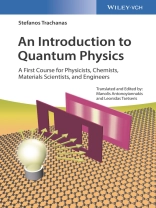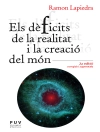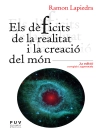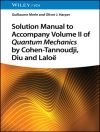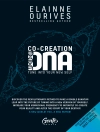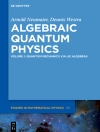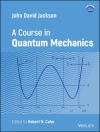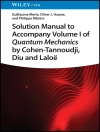This book presents Quantum Mechanics as a theory underlying the world around us, from atoms and molecules to materials, lasers, and other applications. Its features are (a) emphasis on the key principles with minimal mathematical formalism, (b) use of dimensional analysis and order-of-magnitude estimates to develop intuition, (c) comprehensive overview of quantum chemistry and the electronic structure of solids, (d) extensive discussion of the basic processes of lightmatter interactions, and (e) online supplement with advanced theory and multiplechoice quizzes.
‘A famous joke among physicists is that ‘One does not really understand quantum mechanics, but simply gets used to it.’ To an undergraduate student being exposed to quantum physics for the first time, this phrase may come very close to how it feels to speak Nature’s language of the atomic scale. Trachanas’ Quantum Physics aims to remove this feeling and in my opinion it succeeds brilliantly.’
Efthimios Kaxiras, Harvard University
‘Expertly translated, this elegant book by Stefanos Trachanas – a seasoned educator of quantum physics – offers a unique pedagogical approach to quantum mechanics by discussing novel ways to find exact solutions, exploiting useful tools such as dimensional analysis, and providing intuition and physical insight behind the results. Quantum mechanics is a complex field, but this book makes it brilliantly accessible and a delight to learn.’
Nader Engheta, University of Pennsylvania
Cuprins
Foreword
PART I: Fundamental Principles
THE PRINCIPLE OF WAVE-PARTICLE DUALITY: AN OVERVIEW
The Principle of Wave-Particle Duality of Light
The Principle of Wave-Particle Duality of Matter
Dimensional Analysis and Quantum Physics
THE SCHRÖDINGER EQUATION AND ITS STATISTICAL INTERPRETATION
INTRODUCTION: The wave-particle duality as the fundamental law of modern quantum mechanics
The Schrödinger Equation
Statistical Interpretation of Quantum Mechanics
Further Development of the Statistical Interpretation: The Mean-Value Formula
Time Evolution of Wavefunctions: Superposition States and Further Development of the Statistical Interpretation
Self-Consistency of the Statistical Interpretation and the Mathematical Structure of Quantummechanics
Summary: Quantum Mechanics in a Nutshell
THE UNCERTAINTY PRINCIPLE
The Position-Momentum Uncertainty Principle
The Time-Energy Uncertainty Principle
The Uncertainty Principle in the Classical Limit
General Investigation of the Uncertainty Principle
PART II. Simple Quantum Systems
SQUARE POTENTIALS I
Particle in a One-Dimensional Box: The Infinite Potential Well
The Square Potential Well
SQUARE POTENTIALS II
The Square Potential Step: Reflection and Transmission
Rectangular Potential Barrier: Tunneling Effect
THE HARMONIC OSCILLATOR
Solution of the Schrödinger Eequation
Discussion of the Results
A Plausible Question: Can we use the Polynomial Method to Solve Potentials other than the Harmonic Oscillator?
THE POLYNOMIAL METHOD
Sufficient Conditions for the Existence of Polynomial Solutions: Bidimensional Equations
The Polynomial Mehtod in Action: Exact Solution of the Krätzer and Morse Potentials
Mathematical Afterword
THE HYDROGEN ATOM I
Solving the Schrödinger Equation for the Spherically Symmetric Eigenfunctions
Discussion of the Results
What is the Electron Doing in the Hydrogen Atom after all? A First Discussion on the Basic Questions of Quantum Mechanics
THE HYDROGEN ATOM II
The Schrödinger Equation in an Arbitrary Central Potential: The Method of Separation of Variables
The Hydrogen Atom
ATOMS IN A MAGNETIC FIELD – THE EMERGENCE OF SPIN
Atomic Electrons as Microscopiy Magnets: Magnetic Moment and Angular Momentum
The Zeeman Effect and the Evidence for the Existence of Spin
The Stern-Gerlach Experiment: Unequivocal Experimental Confirmation of the Existence of Spin
What is Spin?
Time Evolution of Spin in a Magnetic Field
Total Angular Momentum of Atoms: Addition of Angular Momenta
IDENTICAL PARTICLES AND THE PAULI PRINCIPLE
The Principle of Indistinguishability of Identical Particles in Quantum Mechanics
Indistinguishability of Identical Particles and the Pauli Principle
The Role of Spin: Complete Formulation of the Pauli Principle
The Pauli Exclusion Principle
Which Particles are Fermions and Which are Bosoms
Exchange Degeneracy: The Problem and its Solution
PART III. Quantum Mechanics in Action: Structure of Matter
ATOMS
Arrangement of Energy Levels in Many-Electron Atoms: The Screening Effect
Quantum Mechanical Explanation of the Periodic Table: The ‘Small Periodic Table’
Approximate Calculations in Atoms: Perturbation Theory and the Variational Method
MOLECULES I
The Double-Well Model of Chemical Bonding
Examples of Simple Molecules
Molecular Spectra
MOLECULES II
Hybridization: The First Basic Deviation from the Elementary Theory of the Chemical Bond
Delocalization: The Second Basic Deviation from the Elementary Theory of the Chemical Bond
SOLID STATE
Periodicity and Band Structure
Band Structure and the ‘Mystery of Conductivity.’ Conductors, Semiconductors, Insulators
Crystal Momentum, Effective Mass, and Electron Mobility
Fermi Energy and Density of States
MATTER AND LIGHT
The Four Fundamental Processes: Resonance, Scattering, Ionization, and Spontaneous Emission
Quantitative Description of the Fundamental Processes: Transition Rate, Effective Cross Section, Mean Free Path
Matter and Light in Resonance. I: Theory
Matter and Light in Resonance. II: The laser
Spon
Despre autor
Stefanos Trachanas is an educator, author, and publisher. For over 35 years he has taught most of the core undergraduate courses at the Physics Department of the University of Crete. His books on quantum mechanics and differential equations are used as primary textbooks in most Greek University Departments of Physics, Chemistry, Materials Science, and Engineering. He is a cofounder of Crete University Press, which he led as Director from 1984 until his retirement in 2013. His awards include an honorary doctorate from the University of Crete, the Xanthopoulos-Pnevmatikos national award for excellence in academic teaching, and the Knight Commander of the Order of Phoenix, bestowed by the President of Greece.
Manolis Antonoyiannakis is an Associate Editor and Bibliostatistics Analyst at the American Physical Society, and an Adjunct Associate Research Scientist at the Department of Applied Physics & Applied Mathematics at Columbia University, USA. He received his Ph D from Imperial College London, UK. His editorial experience in the Physical Review journals stimulated his interest in statistical, sociological, and historical aspects of peer review, but also in scientometrics and information science. He is currently developing data science tools to analyze scientific publishing and enhance research assessment.
Leonidas Tsetseris is an Associate Professor at the School of Applied Mathematical and Physical Sciences of the National Technical University of Athens, Greece. He obtained his Ph D from the University of Illinois at Urbana-Champaign, USA. His research expertise is on computational condensed matter physics and materials science, particularly quantum-mechanical studies on emerging materials. He has taught a variety of university courses, including classical mechanics, electromagnetism, quantum mechanics, and solid state physics.
